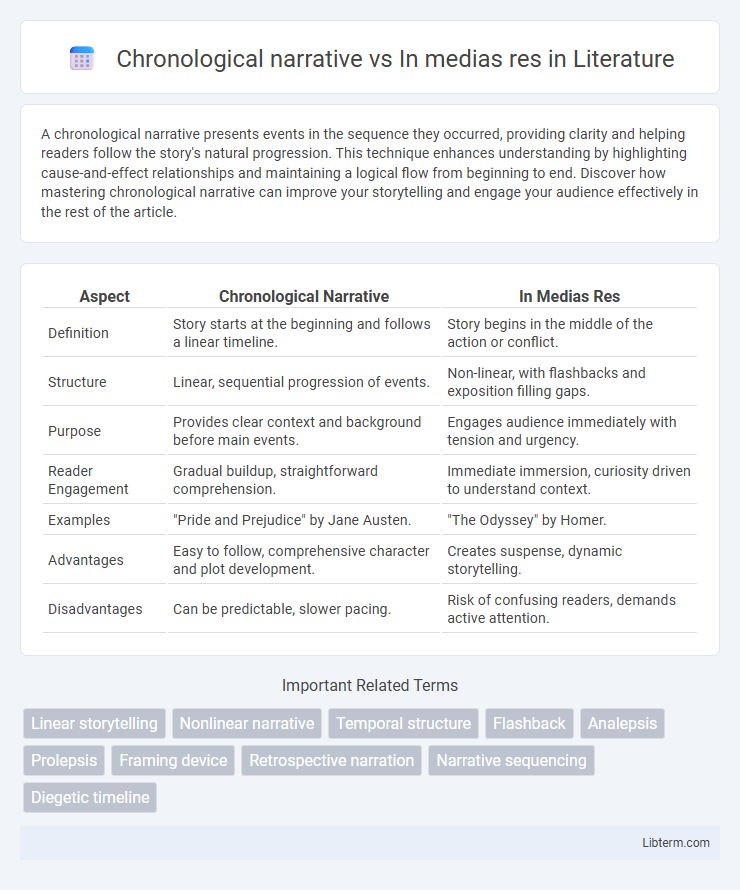A chronological narrative presents events in the sequence they occurred, providing clarity and helping readers follow the story's natural progression. This technique enhances understanding by highlighting cause-and-effect relationships and maintaining a logical flow from beginning to end. Discover how mastering chronological narrative can improve your storytelling and engage your audience effectively in the rest of the article.
Table of Comparison
| Aspect | Chronological Narrative | In Medias Res |
|---|---|---|
| Definition | Story starts at the beginning and follows a linear timeline. | Story begins in the middle of the action or conflict. |
| Structure | Linear, sequential progression of events. | Non-linear, with flashbacks and exposition filling gaps. |
| Purpose | Provides clear context and background before main events. | Engages audience immediately with tension and urgency. |
| Reader Engagement | Gradual buildup, straightforward comprehension. | Immediate immersion, curiosity driven to understand context. |
| Examples | "Pride and Prejudice" by Jane Austen. | "The Odyssey" by Homer. |
| Advantages | Easy to follow, comprehensive character and plot development. | Creates suspense, dynamic storytelling. |
| Disadvantages | Can be predictable, slower pacing. | Risk of confusing readers, demands active attention. |
Understanding Chronological Narrative
Chronological narrative presents events in the order they occur, enhancing clarity and helping the audience follow the storyline seamlessly. This linear structure is commonly used in historical writing, biographies, and traditional storytelling to build cause-and-effect relationships naturally. Understanding chronological narrative allows writers to create coherent plots that emphasize temporal progression and character development.
Defining In Medias Res
In medias res is a narrative technique where a story begins in the middle of the action, bypassing traditional chronological order to engage the audience immediately. This method contrasts with chronological narratives that unfold events from start to finish in sequential order. By dropping readers directly into a pivotal moment, in medias res creates suspense and prompts curiosity about preceding events and character motivations.
Historical Origins of Both Techniques
Chronological narrative traces its origins to ancient historiography, prominently used by historians like Herodotus and Thucydides who documented events in linear order to ensure clarity and educational value. In medias res, rooted in classical epic poetry such as Homer's "Iliad" and "Odyssey," begins storytelling amid action, engaging audiences immediately by revealing backstory through flashbacks and character dialogue. These techniques reflect distinct narrative strategies developed in Ancient Greece, influencing Western literature's approach to time and plot structure.
Structural Differences Explained
Chronological narrative presents events in sequential order, following a linear timeline from beginning to end, which helps readers understand cause and effect clearly. In medias res starts in the middle of the story, immersing the audience directly into action or a critical moment, creating immediate engagement and suspense. This structural difference impacts pacing and comprehension, as chronological narratives build context gradually while in medias res relies on flashbacks or exposition to fill in earlier events.
Reader Engagement: Pros and Cons
Chronological narrative provides a clear, linear progression that helps readers easily follow the plot but may risk reduced immediate engagement due to slower pacing. In medias res starts the story amid action or conflict, capturing reader attention quickly but can cause confusion if background information is delayed or unclear. Effective reader engagement depends on balancing narrative clarity with dynamic storytelling techniques tailored to the audience's preferences.
Narrative Flow and Pacing
Chronological narrative maintains a linear sequence that enhances clarity and steady pacing by presenting events in the order they occur, allowing readers to easily follow the storyline. In medias res begins in the midst of action, accelerating narrative flow and creating immediate engagement, often requiring readers to piece together preceding events through flashbacks. This technique increases tension and dynamism but can challenge traditional pacing by disrupting temporal continuity.
Character Development Approaches
Chronological narrative structures enable gradual character development by presenting events in a linear progression, allowing audiences to witness transformation and growth over time. In medias res begins the story amid action, requiring characters to be established quickly through dialogue, behavior, and flashbacks, creating immediate intrigue and depth. This approach often reveals layers of a character's personality as the narrative unfolds non-linearly.
Impact on Plot Revelation
Chronological narrative structures reveal plot developments in a linear, time-ordered sequence, allowing for gradual buildup and clear cause-and-effect relationships. In medias res, by starting the story in the middle of the action, immediately engages the audience with suspense and prompts active piecing together of prior events through flashbacks or dialogue. This technique heightens tension and accelerates plot revelation, creating a dynamic storytelling experience that contrasts the steady exposition of chronological narration.
Genre Preferences and Trends
Chronological narrative remains dominant in traditional genres such as historical fiction and memoirs, where a linear progression enhances clarity and character development. In medias res gains popularity in contemporary thrillers and fantasy novels, catering to readers' preferences for immediate engagement and suspense through opening scenes placed in the middle of the action. Current trends reveal a hybrid approach blending both techniques to balance immersive storytelling with coherent plot structure.
Choosing the Right Technique
Choosing the right narrative technique depends on the story's pacing and audience engagement objectives. Chronological narrative offers clear, linear progression ideal for complex plots requiring detailed context, while in medias res thrusts the audience directly into critical action, creating immediate tension and curiosity. Writers should evaluate whether gradual development or instant immersion better serves the emotional impact and thematic clarity of the story.
Chronological narrative Infographic

 libterm.com
libterm.com